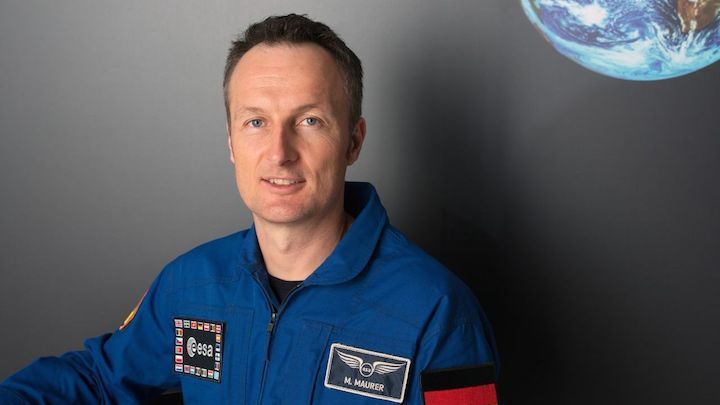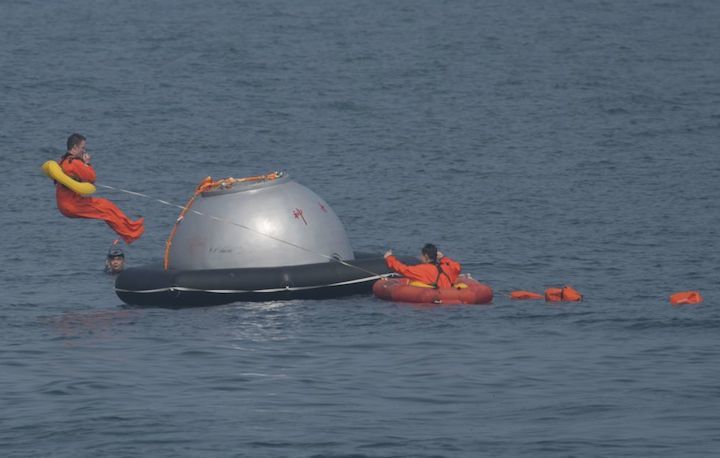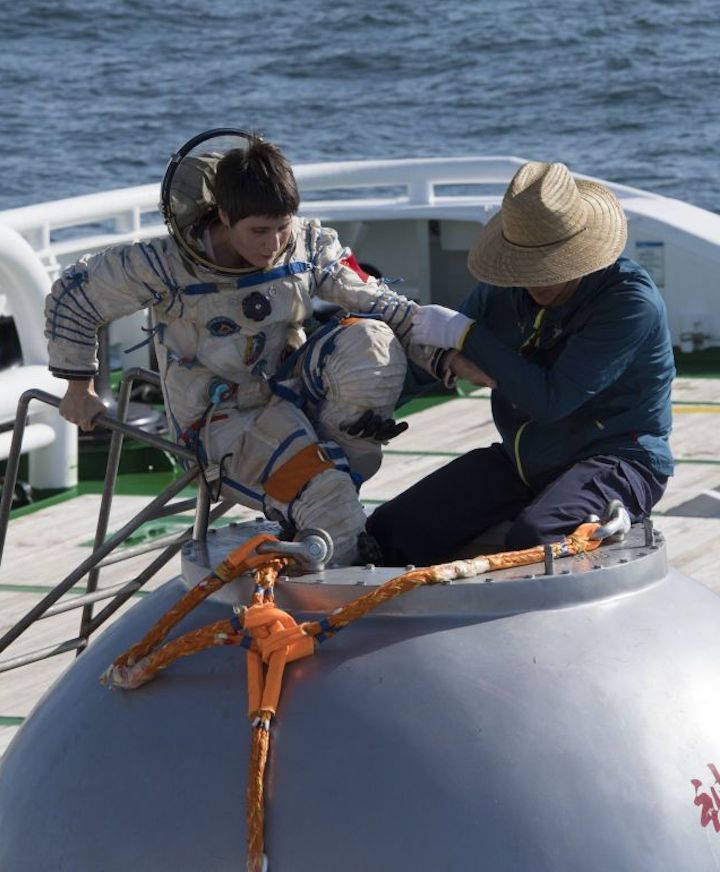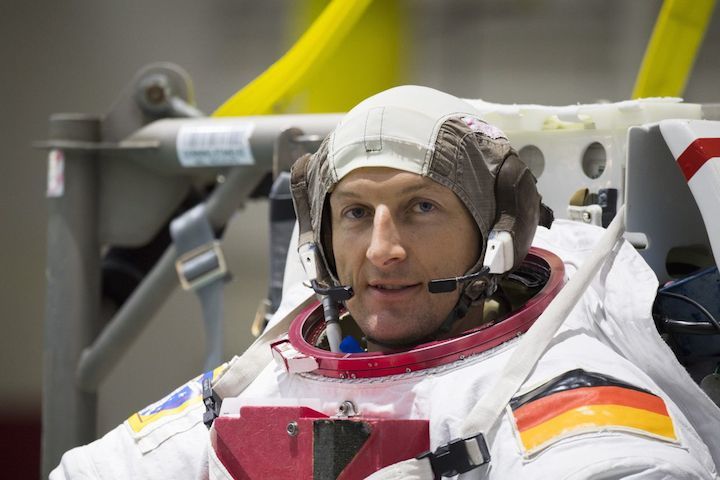13.09.2017
ESA astronaut Matthias Maurer on sea survival training in China and flying to the Chinese Space Station

Matthias Maurer is the European Space Agency’s latest recruit to its astronaut corps, and recently trained with Chinese colleagues. ESA ESA–Philippe Sebirot
-
Matthias Maurer is a European Space Agency astronaut who has a Ph.D. in material science engineering. He joined ESA in 2010 as part of crew support and was part of the first delegation sent to China to establish contact with Chinese colleagues. Matthias was selected in the 2009 ESA astronaut class and officially appointed an ESA astronaut in January 2017. In August, he participated in sea survival training in China with Chinese astronauts.
Matthias talked with us about the training, his Chinese colleagues, international cooperation, learning Chinese and the possibilities of flying to the future Chinese Space Station.
Could you talk us through the training you just completed in China?
The training in China was sea survival training. If you return from space, you can also land in the ocean, and this is similar to the [Russian] Soyuz sea survival training. The capsule is put in the ocean with a crew of three on board. Inside the capsule, you need to change from your pressure suit into your sea survival suit which is a rubber suit. You also have some survival gear that's different to the Soyuz.
You have two inflatable boats among your rescue equipment which you need to inflate when you get outside. And then you need to jump into the water and get yourself on to the inflatable boats. Then you need to check that all your gear is ready. After this, you start using the GPS satellite telephone and all the gear that you have on board, and hopefully you're picked up. In this training, we trained for two possibilities of being picked up from the sea. One was a huge sea rescue ship using a basket to fish us out of the sea, and the second option was a helicopter rescue.
How was it to be in the capsule and perform these tasks and procedures?
Well, actually it was easier than I expected. I have not flown to space, so I have not had the similar training in the Soyuz capsule like my colleagues. But everyone who has flown on the Soyuz and had the sea survival training told me, well, it's very cramped, it's so tiny and hot inside and that's the main challenge - to change first into the winter clothing then into the rubber suit. So it's the heat aspect, such as the risk of getting heat stroke, inside this tiny capsule that is a major risk.
The Chinese Shenzhou capsule is actually much, much bigger than the Soyuz capsule. So that was much easier to change inside from the pressure suit into the rubber suit. And so, the heat problem was also not as severe as I had expected from what my colleagues told me about the Soyuz training. Sea sickness was also a risk that was talked about, but in the end everyone mastered it without becoming seasick.

ESA astronaut Matthias Maurer leaps from a Shenzhou capsule at Yantai, Shandong Province, in August 2017.
We had in total nine astronauts in training during the two weeks that we were there. My colleague and I, Samantha Cristoforetti, an Italian astronaut, were the two Europeans. And then we had seven Taikonauts, or Chinese astronauts. And in total we formed three teams of three each. For example, Yang Liwei was among team one with Wang Yaping, the second Chinese female astronaut and Zhang Xiaoguang. Team two was Liu Boming, Ye Guangfu and myself. And team three was Liu Wang, Chen Dong and Samantha Cristoforetti.
They have obviously trained for sea survival before, but never on the open sea. And so we were the first astronaut batch to use a brand new sea survival training centre in Yantai. Three other teams of astronauts also did this training before we were there, so in total there were 18 astronauts trained.
How did you and Sam Cristoforetti get along as a team with your Chinese colleagues?
Within the Chinese astronaut family, it was a very warm-hearted welcome! It was incredible. So Samantha and I, we immediately felt we were part of one family. We had breakfast together, we had lunch together, we had dinner together and in between we trained together and in the evening we walked along the beach and discussed things. So it was a really, really nice feeling.
And on a personal note, I believed this cooperation would work without any problems. The language barrier challenge is just to be efficient and safe while doing business. That is what I see as the main obstacle. I'm convinced that on the personal side and on the working level side, they would make ideal, perfect partners for the international community flying to space because the Chinese are as interested in and as motivated to fly to space as our American colleagues, or the Russian colleagues or the Japanese or the Canadians.
Both you and Sam Cristoforetti were speaking Chinese very well in Chinese television interviews. How long have you and any other ESA astronauts been learning the language?

ESA astronaut Samantha Cristoforetti joined Chinese colleagues in Yantai, China to take part in their sea survival training, on 15 August 2017.
Well, we still need to improve. Language is still the main obstacle for future cooperation. In 2012, Thomas Pesquet, my French astronaut colleague, and me, we started learning Chinese. Samantha had already started learning Chinese at university. And we are the only three European astronauts who are currently learning Chinese. We are looking forward to hopefully flying with the Chinese in the 2020s to the Chinese Space Station. Depending on how much time we have for other training or other activities, there are times when we learn a lot intensively and then there are times when we have less time. For example, Thomas was in space for half a year and obviously during that time and during the intensive training for his mission, he had little or no time to practice his Chinese.
Could you give an example of the language and the cultural challenges when you were cooperating with your Chinese counterparts?
Whenever you have a procedure and it is written in Chinese characters and if it's not in your mother tongue, it slows you down extremely. The risk of misunderstanding, if you don't know a Chinese character, is much bigger than if you don’t understand a word in the Latin or Cyrillic alphabet. So reading Chinese and running written procedures, for me, still seems like a big, big step.
We hope that we will go to bilingual procedures as we did for the ATV [Automated Transfer Vehicle cargo spacecraft], for example, where we had the same procedure on one page in English and one page in Russian. And so we hope that with the cooperation of the Chinese, we will have important procedures on one page in Chinese and one page in English. When you have voice communication, you need to talk in the capsule with the crew, and that went pretty well. I understood the Chinese quite well and the Chinese understand English quite well. So in between using the two languages, this worked out. Samantha and I are still at the mid-level of Chinese, so before we fly with the Chinese obviously we will have to spend one or two years in China just to improve our Chinese.
How big a step would you say this training was in spaceflight cooperation between ESA and China?
I would say it's a massive step forward because for the very first time we have foreign astronauts in China. For them it was really, really important. This training was so well prepared. They described it in their own press as feast-for-the-eyes training because of the technical effort that they put into this training - there was way more in there than you actually need. So, for example, the helicopter and the huge sea rescue ship, you could have done with a smaller vessel and a smaller helicopter, I would say. Overall it was outstanding. It was according to international standards, definitely.
ESA and China have also already cooperated on CAVES training, in 2016. What could be the next steps that the two sides could take?
In 2013, when I was over in China with Thomas Pesquet and some European management from ESA, we also looked into their capsule and their simulator. We performed docking and undocking, we talked about astronaut selection, about medical standards, and the first time that we did real training was that year. But the other stuff was also important to get to know how they work and how they do their business and how we could potentially work together in the future, where we see obstacles.
I believe it's the language that has been the main obstacle. So how would we do operations in the future and how would we talk? And will it be only Chinese that we talk on the loops or will we have European ground support personnel involved? Could we have Chinese and English being used in parallel? These are the big questions. But we’re looking for the way forward. I believe that the next step again is on a management level where the roadmap that is currently being worked on needs to be approved so that the next steps can be formally put together.
How significant do you think it is that ESA is now looking to increase cooperation with China for the post-International Space Station era?
Well, ESA recognises China as one of the main players. China has independent access to space for humans. They will soon have their own space station in low Earth orbit. And so, from my personal view, I see them on the same level as the Russians or NASA: an independent space agency that can do everything they want to do in space. So, if we bring the Chinese into the international community, then the international spacefaring community will profit from that, and we will become much stronger. If the next goal is exploration, then we need to have all the competencies that we can find around the globe. The ESA director-general strongly promotes the idea that when we fly to the Moon we should have the Chinese participating in this international endeavour.

ESA astronaut Matthias Maurer joined Chinese colleagues Liu Boming and Ye Guangfu in Yantai, China to take part in their sea survival training, on 19 August 2017.
What does ESA have to offer in this regard?
ESA itself consists of 23 member states. So every day we are facing this problem of having different languages and different cultural backgrounds, and we know how to handle this and how to work efficiently together. So ESA itself is the perfect glue to build a link between the Chinese and the other international partners. ESA has a lot to offer the Chinese. We now have much more than 2,000 astronaut days in space. We have vast experience on the International Space Station and the Chinese are currently in the phase where they are preparing their new station. And they have to switch from a single mission, short-duration concept like the space shuttle mission, to make a comparison to the space station mode. So that is a huge, huge step, and ESA can help the Chinese to make this step.
If cooperation between ESA and China results in a joint flight to the Chinese Space Station in the 2020s, I suppose the material science section of the experiment module would be of particular interest to you.
Material science is what my heart speaks to, but it's not only material science. I mean, I also have a background as a paramedic. I didn’t do military service, I did the civil service, so life science is of interest and after my studies, I worked in an international company that produces blood filters, so fluid physics is also a main point there. So I think I cover a lot of the research topics with my background from university and from practical experience, therefore the ISS and the Chinese Space Station would be definitely interesting.
When are you targeting your first trip to space?
I hope to be on the 2020 flight, which is the next European flight is not yet assigned. But obviously I'm not the only one who is wishing or hoping for the 2020 flight. So it might also slip to 2021 or 2022. Definitely, that is the timeframe that I believe I will be in space.

Matthias Maurer, German ESA astronaut and material scientist, during spacewalk training in the Neutral Buoyancy Laboratory near NASA's Johnson Space Center, in Houston, Texas, in April 2017.
